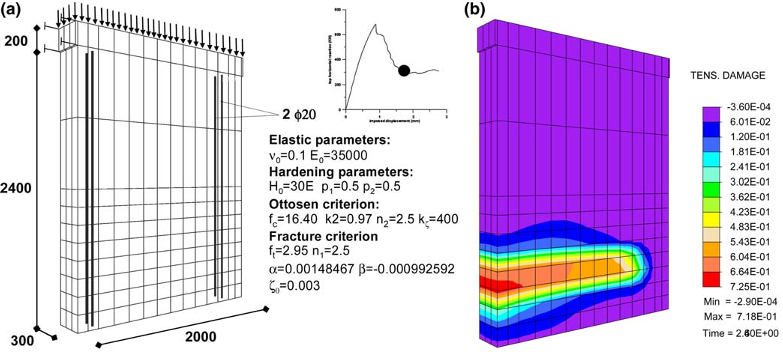Q2. What is the underlying assumption for the hardening potential?
The underlying assumption for the hardening potential (6) is that, after a rather low level of stress, irreversible phenomena such as microcracks occur, causing irreversible strains as well as a decay of the tangent stiffness.
Q3. What is the generalized elastic domain K?
The generalized elastic domain K is defined in the extended space of stresses, thermodynamic forces and conjugated damage variables.
Q4. What is the main observation that the model attempts to reproduce?
The main experimental observation that the model attempts to reproduce is the lack of a clearly defined elastic response except for very small deformations; actually, damage and cracks form and develop from very low values of the load, well before the peak stress is attained.
Q5. What is the dimension of the reference volume to which the model applies?
That is the dimension of the reference volume to which the model applies is large enough so that the energy flux through its boundaries is due only to the mechanical work of the stresses.
Q6. What is the main problem in constructing a full triaxial model for concrete?
One major problem in constructing a full triaxial model for concrete is that many experimental observations apply to uniaxial behavior, and indeed a variety of models, empirically founded, exists for the uniaxial response, that are of great utility in the practical analysis of frame members.
Q7. What is the effect of the damage on the elastic moduli?
damage affects the elastic moduli for tensile or compressive stress states differently, since a discontinuity is observable in loading unloading stress paths.
Q8. What is the simplest definition of the dual potential?
The dual (complementary) potential proposed is the indicator function of a suitable generalized elastic domaindcðsÞ ¼ indKðsÞ KðsÞ ¼ s : gðsÞ 6 0f g ð9Þg(s) being the yield function.
Q9. What is the reason for the deviation in the numerical simulation of lateral strain from experimental data?
The necessity of some correction on the experimental data is one reason for the deviation in the numerical simulation of lateral strain from experimental data for high values of the axial strain.
Q10. What are the parameters that affect the peak stress, the post-peak region, the ampli?
The values of the damage parameters n2 and kf essentially affect the peak stress, the post-peak region, the amplitude of the area below the r e curve and the unloading modulus as well.
Q11. What is the kinematic damage of the cap g3?
Da ln a ka(In this kind of loading condition the kinematic damage variables are constantly null, be-cause only the cap g3 is activated, that is no damage develops in hydrostatic compression.
Q12. What is the common choice when a bimodular material model is adopted?
The choice commonly assumed when a bimodular material model is adopted (Comi and Perego, 2001; Faria et al., 1998) is coupled with an isotropic damage model.
Q13. What is the simplest choice for separating the elastic energy?
The simplest choice directly derived by the original Curnier proposal, is to take, as separating interface, the deviatoric plane tr ee 0 in the space of the elastic strain.





